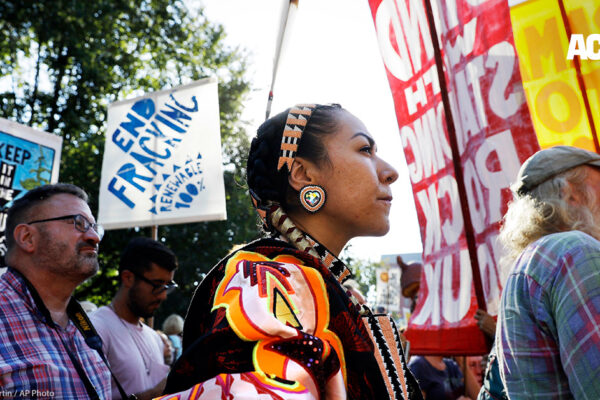In 1968, President Lyndon Johnson signed National Hispanic Heritage Week into law. Twenty years later, Ronald Reagan announced its expansion from a weeklong celebration to one that would last an entire month.
Hispanic Heritage Month (HHM) kicks off Sept. 15—a date that marks the anniversary of independence for Costa Rica, Guatemala, Nicaragua, Honduras, and El Salvador. The month also includes the independence days of Mexico and Chile—Sept. 16 and 18, respectively. Unfortunately, Oct. 12—a day that has long lived in infamy and one that continues to be commemorated as Columbus Day by many—also falls within the monthlong period.
Created to celebrate the achievements and contributions of Hispanic people in this country, HHM too often ignores just what the arrival of Spanish explorers meant to Indigenous peoples of this hemisphere. School lessons continue to offer a romantic narrative of a daring explorer, Christopher Columbus, who discovered the Americas, but what ultimately was wrought on the American continent—and the long-lasting negative effects it has left on its native inhabitants—has not been taught adequately at all. The arrival of Columbus, an Italian captain working for the Spanish crown, brought on genocide directed against Indigenous communities. His journeys marked the beginning of centuries of colonization and opened the doors to the trans-Atlantic slave trade. By celebrating Columbus Day as part of HHM, we honor a legacy of conquest and support the erasure of Indigenous peoples and their history. Many Spanish men eventually had children with Indigenous women and intermarriage became common, so that today many people who identify as Hispanic or Latinx have Indigenous heritage. That's why celebrating Columbus Day, and the bloody arrival of the Spanish Conquistadores, is so misguided and grossly ironic.
HHM also fails to adequately celebrate the diversity of the people found today in the Americas. The terms “Hispanic” and “Latino” have been used interchangeably despite the distinction that exists between them. Generally, Hispanic refers to persons who speak Spanish or who are descended from Spanish-speaking countries, while Latino/Latina/Latinx refers to geography, specifying persons from Latin America.
The 1970 census greatly undercounted Latinx populations in the United States and that led to the addition of the term “Hispanic” on the U.S. Census short form by 1980. Although used by cultural and political activists primarily to unify a segment of the population, with the goal of creating a single Hispanic identity that could someday hold political and economic power, the term has a contentious history and is not universally accepted.
In the attempt to create a monolithic identity, the term Hispanic ignores distinct populations and histories; and HHM falls short when it focuses on a singular Hispanic identity using a European lens instead of looking at the diversity of Indigenous communities in the Americas. There are hundreds of distinct Indigenous peoples spread across Latin America. In certain Latin American countries Indigenous people comprise a major portion of the population yet remain largely marginalized. Once they arrive in the United States, Indigenous Latinx are regularly categorized as Hispanic based solely on their country of origin, without regard to differences in culture, religion, or language. Not all Indigenous Latinx speak Spanish, but instead speak Indigenous languages.
Critical Latinx Indigeneities (CLI) is a school of thought that challenges the notion of a collective identity, especially one that is fraught with internalized racism where those who are lighter-skinned, who identify as mestizo, and speak Spanish are the ones who benefit most from the Hispanic label. This approach imposes assimilation on Indigenous populations without their consent and further contributes to their invisibility.
The erasure of Indigenous Latinx communities is problematic because it leads to a lack of representation of Native peoples. Some non-Indigenous people even question whether these communities still exist in the present. Their histories and experiences are disregarded. Spaces where ignorance and misinformation feed negative stereotypes are permitted to flourish to the extent that Indigenous Latinx groups become vulnerable to further prejudice and discrimination. To not fall into the trappings of a settler/colonial mindset that continues to "otherize" and exclude Indigenous Latinx people, it is crucial to shine a light on authentic representations of these populations, highlighting that these are distinct groups that do not fall under a uniform Hispanic or Latinx identity.
The work must be holistic in nature, looking to the past to acknowledge the legacy of colonialism and how that history continues to impact communities today. A major step in this direction would be the dismantling of a commemoration of Columbus Day that focuses on a Eurocentric model of discovery and that ignores the atrocities committed on Native populations in the United States as well as in Latin America.
In lieu of promoting a white-washed version of history, Indigenous Peoples’ Day turns the tables and places the narrative in the hands of its rightful custodians. It honors the cultures and contributions of these populations and reminds us that they are present today, and that they are relevant. More importantly, celebrating Indigenous Peoples’ Day recognizes the resilience of these communities and reinforces the understanding that visibility and representation matter.

